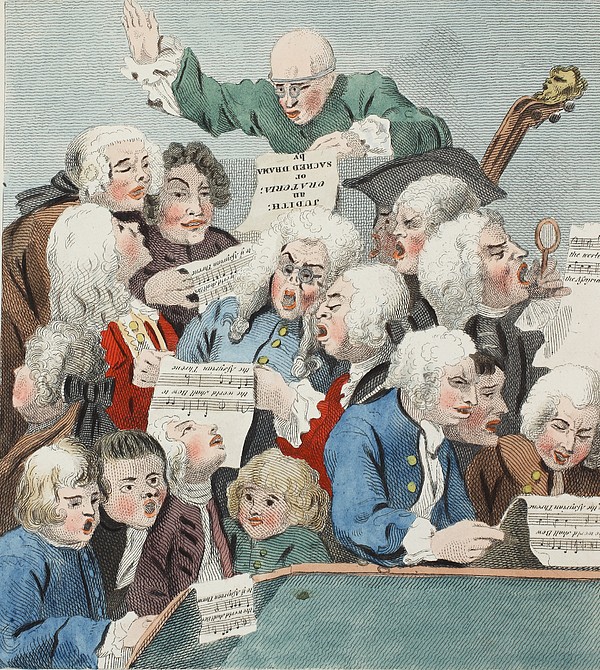
Le chœur sensible. La choralité dans le long XVIIIe siècle / Chorality in the long 18th century (ASECS 2021, en ligne)
Appel à communication pour un panel tenu au congrès annuel de l'ASECS (American Society for Eighteenth-Century Studies) *EN LIGNE* du 8 au 10 avril 2021.
Call for papers for a panel held at ASECS (American Society for Eighteenth-Century Studies) annual *ONLINE* meeting from the 8th to the 10th of April 2021.
Les propositions sont bienvenues en français comme en anglais.
Du grec ancien χορός, le chœur étend son sens au XVIIIe siècle à une foisonnante multitude de domaines. De la scène lyrique à la scène dramatique, des chœurs formels aux chœurs en chair et en os – voire aux chœurs en pierre des églises et aux chœurs d’opinion des conversants salonniers –, du chœur législatif aux enfants de chœur du pouvoir, le chœur désigne un ensemble composé de parts distinctes, mais agissant de concert. Les différentes "choralités" sont organisées ou spontanées, subordonnées à un ordre établi ou constituées en sujets autonomes d'expression collective. Ce panel interdisciplinaire propose une réflexion sur les formes du fait choral dans le long XVIIIe siècle.
Proposals welcome in French or English.
The long eighteenth century is rife with “chorality”. As a preliminary definition, choirs gesture towards a composite ensemble whose distinct parts act in concert – or at least endeavour to. Depending on whether its form is plural or unified, organized or spontaneous, chorality can either constitute subordination to a norm or the creation of a subject for collective expression. This panel welcomes papers on a broad range of subjects, from printed choral forms to those presented on lyrical and dramatic stages and the life of the flesh-and-bones troupes that sing them; from physical, architectural choirs to legislative choirs and from popular choirs to the "choir boys" of the establishment.
Examples of possible subjects include, but are of course not limited to: / Quelques exemples de sujets, non limitatifs :
- chorality in the literary works of Voltaire or Cahusac / la choralité dans les œuvres de Voltaire ou de Cahusac
- Rousseau and choruses of Paris and Geneva / les chœurs de Paris et de Genève chez Rousseau
- studies on architectural choirs in Blondel / les études sur les chœurs architecturaux chez Blondel
- choirs in the street and popular choirs / les chœurs de rue, les chœurs populaires
- choral singing in colonial or missionary contexts / l'activité chorale en contextes coloniaux ou missionnaires
- political choirs from the Glorious, the Haitian, the French revolutions / les chœurs révolutionnaires
- musicological studies of choral repertoire sung by Lutheran choirs of Bach’s time / des études musicologiques de répertoire choral du temps de Bach
- reflections on choirs and gender in Casanova’s Icosameron / des réflexions sur le genre et les chœurs dans l'Icosameron de Casanova
- choral iconography: the decoration of church choirs / des études iconographiques sur la décoration des chœurs d'églises
- representations of choirs in Hogarth caricatures / représentations de chœurs dans les caricatures de Hogarth
- histories of men’s, women’s and mixed choral societies / histoires de chœurs mixtes, de femmes ou d'hommes
- use of choral therapy in medical contexts like for Leuret’s patients at Bicêtre or Esquirol at la Salpêtrière / l'usage thérapeutique de la musique chorale chez Esquirol ou Leuret
- choral theory in treatises from Brossard to Lacépède / théorie chorale dans les traités musicaux du XVIIIe siècle
etc.
*
Prière d'envoyer de courtes (environ 200 mots) propositions avec bibliographies sélectives avant le 15 octobre 2020 à / Please send short (around 200 words) propositions with selective bibliographies before October 15th 2020 to: